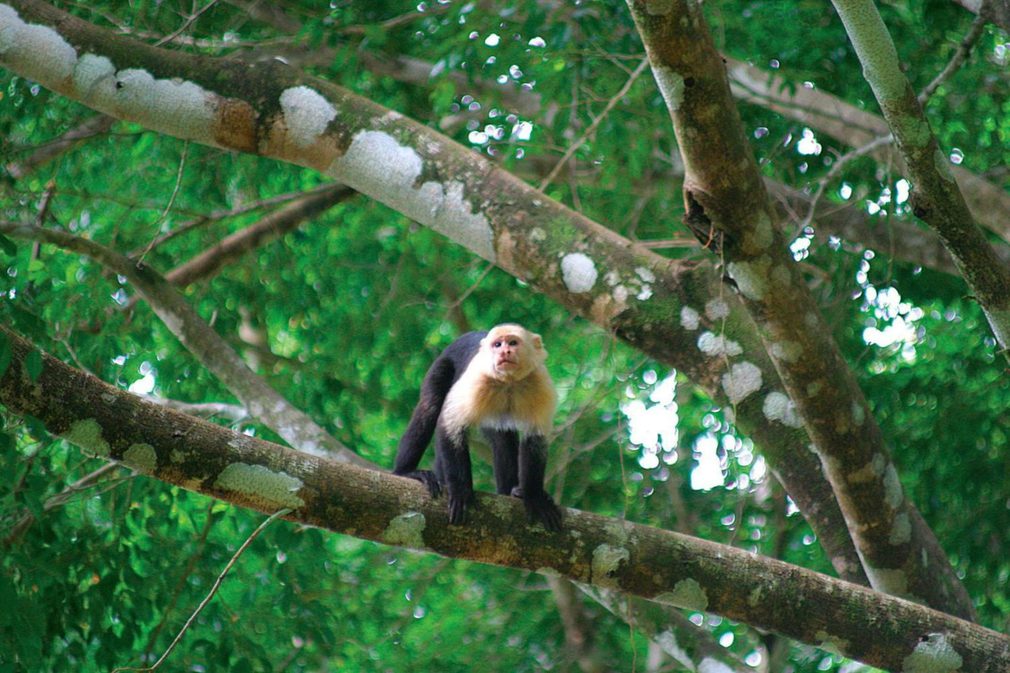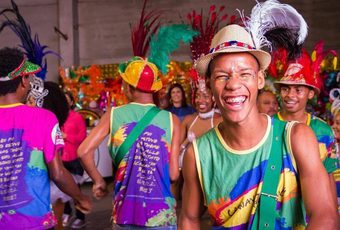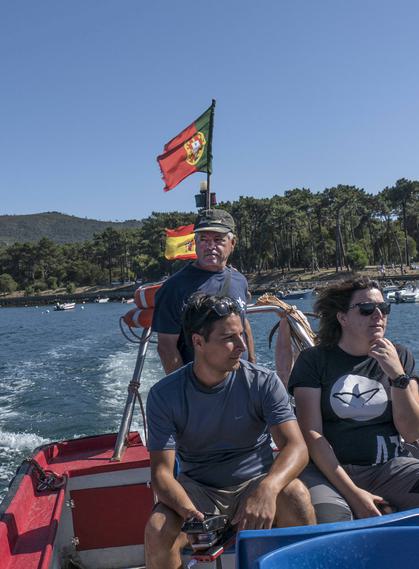Blog
The 9 best wildlife spots in Costa Rica

Costa Rica might only covers 0.03% of the planet's surface, it is home to 5% of the world’s biodiversity, making it the highest density of species of any country in the world.
The extensive network of national parks, wildlife refuges and other protected areas (constituting 25% of the territory) is one of the reasons why wildlife thrives here.
Every year thousands of birdwatchers and wildlife enthusiasts gather in Costa Rica in a bid to spot some of the 850 bird and 260 animal species recorded within its boundaries such as: the four-eyed opossum, silky anteater, elusive tapir, dazzling hummingbirds, resplendent Quetzal or any of six species of neotropical cats living here (jaguar, puma, ocelot, margay, oncilla and jaguarundi) as well as monkeys, sloths and coatis.
Of course spotting wildlife depends on the season, luck and a lot of patience. Night and early hikes as well as taking a guide with you are probably the best way to put the odds on your side.
Please note that the quoted ‘best times’ to visit are based entirely on the wildlife - they often coincide with the rainiest, and therefore quietest times of year.
Before listing our favourite wildlife spots in Costa Rica, have a look at our Hidden Highlights of Costa Rica road journey from the Caribbean to the Pacific.
Corcovado National Park
Famously labeled by National Geographic as ‘the most biologically intense place on earth,’ this is one of the only places where you’ll be able to spot all four Costa Rican monkey species in one location. It is wet, remote and rugged although relatively good trails makes it a good option to spot Costa Rica’s shyest and most endangered species.
Best time to visit: August to September
Wildlife Highlights: snowy egret, bare-throated tiger heron, rufous-tailed jacamar, harpy eagle, crested guan, black-throated trogan, mealy parrot, chestnut-mandibled toucan, scarlet macaw, american crocodile, boa, dreaded bushmaster, frogs, lizards, butterflies, white-nosed coati, white-throated capuchin monkey, spider monkey, squirrel monkey, mantled howler monkey, collared peccary, white-lipped peccary, baird's tapir and jaguar.
Tortuguero National Park
Only accessible by plane or boat this park is often referred as the ‘mini Amazon,’ hosting one of the world’s foremost turtle nesting beaches. Its extensive network of freshwater creeks and lagoons feature many amphibians and birds that exist nowhere else in Costa Rica. The wildlife viewing experience here is quite unique as it is mainly done from boats. Note that sharks and strong currents make the beaches unsuitable for swimming.
Best time to visit: July to September
Birds Highlights: laughing falcon, osprey, amazon kingfisher, montezuma oropendola, great patoo, roseate spoonbill, green macaw, violet sabrewing, toucan, sunbittern, spectacled caiman, american crocodile, river turtle, green sea turtle, olive ridleys turtle, leatherbacks turtle, emerald basilisk, yellow-headed gecko, dart frog, boa constrictor, sloth, white-throated capuchin monkey, spider monkey, mantled howler monkey, river otter, west indian manatee.
Caño Negro Wetlands National Wildlife Refuge
Close to the Arenal Volcano, this place offers a similar viewing experience to Tortuguero in that it is all done by boat. Although Caño Negro is definitely not rainforest, this is a great alternative if you want to see the wildlife much closer. Every year, millions of birds arrive here to winter during the dry season beginning in December.
Best time to visit: December to May
Wildlife Highlights: anhinga, neotropical cormorant, heron, egret, jacana, amazon kingfisher, toucan, inca dove, laughing falcon, crested caracara, ibis, roseate spoonbill, spectacled caiman, river turtle, sloth, capuchin monkey, spider monkey, mantled howler monkey, long-nosed bat, jaguar, cougar, tayra, ocelot, tapir, white-tailed deer, bull shark.
Marino Ballena National Park
Named after the Humpback Whales that migrate here to mate each year, this place also offers good snorkelling and diving experiences, although you need to be careful of currents and riptides. On the coast, Olive Ridley and Hawksbill turtles lay their eggs between May and November.
Best time to visit: September
Wildlife Highlights: frigate bird, brown footed booby, pelican, ibis, green marine iguana, olive ridley and hawksbill turtle, humpback whale, bottle nosed and common dolphin, coral, sponge, anemones lobsters, trunkfish.
Los Quetzales National Park
Costa Rica's newest national park (formerly the Reserva Los Santos) is located in the heart of the semi-Alpine Cordillera de Talamanca. This area is remarkably diverse as the Savegre watershed contains approximately 20% of the registered bird species in Costa Rica. True to the park's name, the resplendent quetzal lives here as well as other endangered species.
Best time to visit: December to May
Wildlife Highlights: resplendent quetzal, colibri, goldfinch, trogon, tanager, hummingbirds, eye-popping parrot, toucan, redstart, wren, woodpecker, sloths, coyote, jaguar, puma, baird’s tapir, collared peccaries, tayra, deer, black guan, squirrel monkey.
Tenorio Volcano National Park
Primary known for hosting the stunning sky blue Rio Celeste, its trails are also great for watching rare wildlife species such as tapirs or squirrel monkeys. Moreover, the location of this park makes it great to spot birds, indeed as the ground creates a natural flyway to Lago Nicaragua many migratory species travel through this park.
Best time to visit: December to May
Wildlife Highlights: tody motmot, bear-necked umbrella bird, sunbittern, trogon, toucan, crested guan, woodpecker, hummingbird, ruffous-necked tanager, baird’s tapir, spider monkey, howler monkey, white-faced monkey, puma, jaguar, tayra, ocelot, collared peccaries, hawks, turkey vultures.
Carara National Park
One of Costa Rica’s most popular National Parks due to its proximity to San José, Carara is a bird watchers favourite. You’ll easily find competent amateur birders who will be pleased to teach and show you the fauna of the park. Because it is slightly dryer than the rainforests further south, wildlife spotting is much easier here.
Best time to visit: January to April
Wildlife Highlights: aracari, american egret, great tinamou, long-billed gnat wren, chestnut-backed antbird, toucan, anhinga, jacana, pied-billed grebe, boat-billed heron, opossum, two-toed sloth, agouti, armadillo, pacas, great anteater, kinkajou, tayra, margay cat, collared peccary, white-tailed deer, monkeys.
Guanacaste National Park
Filled with many areas of scenic beauty, lush trails and paths, and beautiful winding rivers, an important aspect of this park is that it has been created as a biological corridor (as it is connected to Santa Rosa National Park) for seasonal migrating species. Moreover it houses four biological stations, which means most people here are scientists rather than tourists.
Best time to visit: December to April
Wildlife Highlights: white-throated magpie jay, orange-fronted parakeet, and crested caracara, squirrel cuckoo, tanager, groove-billed ani, collared peccary, howler monkey, white-nosed coati, white-tailed deer, variegated squirrel, long-tongued bat, capuchin monkey, jaguar.
La Amistad International Peace Park
The largest protected region of Costa Rica, much of which is still unexplored, has more virgin forest than all of the other parks together. It is estimated that two-thirds of the total country’s species live here: 60 species of reptiles and amphibians, 400 species of birds, 100 species of fish, and the largest populations of jaguars in Central America. Access is pretty difficult and having an experienced guide with you is highly recommended - if not mandatory.
Best time to visit: February to March
Wildlife Highlights: baird’s tapir, giant anteater, jaguar, puma, ocelot, margay, oncilla, jaguarundi, spider monkey, squirrel monkey, white-nosed coati, three-wattled bellbird, resplendent quetzal, yellow-green finch, bare-necked umbrellabird, splendid poison frog.
The Pothole is Pura Aventura's popular monthly email. We share what we love, what interests us and what we find challenging. And we don't Photoshop out the bits everyone else does. We like to think our considered opinions provide food for thought, and will sometimes put a smile on your face. They've even been known to make people cry. You can click here to subscribe and, naturally, unsubscribe at any time.
The Pothole is Pura Aventura's popular monthly email. We share what we love, what interests us and what we find challenging. And we don't Photoshop out the bits everyone else does. We like to think our considered opinions provide food for thought, and will sometimes put a smile on your face. They've even been known to make people cry. You can click here to subscribe and, naturally, unsubscribe at any time.








 By
By